신생아의 외부 생식기(바깥 생식기/외생식기), External genitalia of newborn infants
- 출생 전 태아는 모체에서 정상적으로 에스트로겐 등 여성 호르몬을 공급받는다. 갓 태어나서 생후 1∼2주가 될 때 까지 여 신생아들의 질에서 달걀 흰자위 비슷한 점액이 정상적으로 분비될 수 있다.
- 이런 분비물은 생후 1∼2주 지나면 더 이상 나오지 않는 것이 보통이다.
- 생후 3∼7일경 일부의 여 신생아들의 자궁 내벽에서 피가 조금 나와 피가 기저귀에 묻을 수 있다. 이것도 정상이다.
- 남 신생아들의 고환이 양쪽 음낭 속에 한 개씩 들어있는 것이 정상이다.
- 음낭 속 고환을 손으로 만져 볼 수 있다.
- 고환이 음낭 속에 정상적으로 들어 있지만 어떤 때는 음낭 속에 있던 한쪽 고환 또는 양쪽 고환이 샅 위쪽에 있는 서혜관 속으로 일시적으로 올라가 잠시 동안 거기에 있다가 음낭 속으로 다시 내려 올 수 있다.
- 이 때문에 어떤 때는 고환이 음낭 속에서 일시적으로 만져지지 않을 수 있다.
- 태어날 때부터 어떤 신생아의 고환이 음낭 속에 들어 있지 않고 복강 내, 또는 서혜관 속에 계속 머물러 있을 수 있다. 이런 고환을 잠재 고환이라 한다.
- 잠재 고환 중 일부는 태어난 후 자연적으로 음낭 속으로 점점 내려온다.
- 드물게 신생아의 음낭 속에 고환이 들어있으면서 그 음낭 속에 체액이 고일 수 있다. 이것을 음낭수종이라 한다(음낭수종 참조).
- 음낭의 바로 위 부위에 있는 사타구니(샅) 부위를 서혜부라 한다.
- 탈장이 서혜부의 한쪽, 또는 양쪽에 있을 수 있다.
- 이것을 서혜부 탈장이라 한다.
- 서혜부 탈장이 있으면 서혜부가 불룩해 질 수 있다([부모도 반의사가 되어야한다-소아가정간호백과]-제 9권 소아청소년 소화기계 질환-서혜부 탈장 참조).
- 서혜부 탈장은 남녀 신생아들이나 신생아기 이후의 남녀 영유아기, 학령기, 사춘기의 아이들, 또는 남녀 성인들에게도 생길 수 있다.
- 갓 태어난 모든 남 신생아들의 자지의 귀두 부분은 음경 귀두 피부로 꼭 싸여있는 것이 정상이다.
- 귀두 부분을 싼 피부를 포피라고 한다.
- 자지(음경)의 귀두 부분에서 포피를 음경 뿌리 쪽으로 일부러 까 젖혀 줄 필요가 없고 포경수술로 포피를 꼭 떼어낼 필요도 없다.
- 포경수술을 받아 생긴 수술 환부가 다 나을 때까지 의사의 지시에 따라 치료한다([부모도 반의사가 되어야한다-소아가정간호 백과]-제 6권 신생아 성장 발육 양호 질병-포경수술 참조).
- 신생아의 식도, 위, 소장, 대장 등의 폐쇄증을 참조.
- 태어날 때 있는 그대로 성장하도록 포경수술을 권장하지 않는다.

사진 2-186. 임신 중 모체에서 받은 여성 호르몬의 영향으로 여 신생아들의 음핵이 뚜렷하게 커져있다. 대음순도 커져있고 외음부의 색깔도 짙다. 이 모두가 정상적인 생리 현상이다.
Copyright ⓒ 2012 John Sangwon Lee, MD., FAAP

사진 2-187. 분만 중 산도에 눌려 신새아의 음낭이 부었다. 이것도 자연적으로 곧 회복된다.
Copyright ⓒ 2012 John Sangwon Lee, MD., FAAP
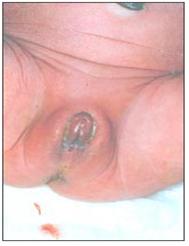
사진 2-188. 기저귀에 묻은 피 반점은 1주된 여 신생아의 자궁에서 나온 출혈로 생긴 것이다.
Copyright ⓒ 2012 John Sangwon Lee, MD ., FAAP
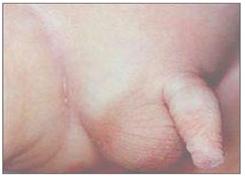
사진 2-189. 포경수술을 받지 않은 남 신생아의 정상 자지.
Copyright ⓒ 2012 John Sangwon Lee, MD., FAAP
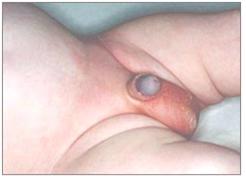
사진 2-190. 포경수술을 받은 남 신생아의 자지. 여기서 붉은 색의 귀두를 볼 수 있다.
Copyright ⓒ 2012 John Sangwon Lee, MD., FAAP
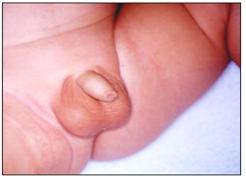
사진 2-191. 포경수술을 받지 않은 남 신생아의 정상 자지.
Copyright ⓒ 2012 John Sangwon Lee, MD., FAAP
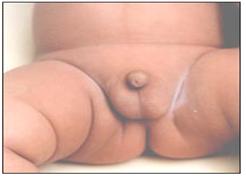
사진 2-192. 포경수술을 받지 않은 남 신생아의 정상 자지
자지의 크기는 정상적으로 차이가 없다.
Copyright ⓒ 2012 John Sangwon Lee, MD., FAAP
The external genitalia of newborn infants
• Before birth, the fetus is normally supplied with female hormones such as estrogen from the mother. From birth until 1 to 2 weeks of age, the vagina of a female newborn may secrete a mucus similar to egg white normally.
• It is normal for these secretions to no longer come out after 1 to 2 weeks after birth.
• Around the 3rd to 7th day of life, some female newborns may bleed a little from the lining of the uterus, which may stain their diapers. This is also normal.
• It is normal for male newborns to have one testicle in each scrotum.
• You can feel the testicles in the scrotum.
• The testicles are normally in the scrotum, but sometimes one or both testes that are in the scrotum may temporarily rise into the groin above the groin, stay there for a while, and then come back down into the scrotum.
• Because of this, the testicles can sometimes be temporarily unpalpable in the scrotum.
• From birth, a newborn’s testicles may remain in the abdominal cavity or in the groin instead of in the scrotum. These testicles are called latent testicles.
• Some of the latent testes gradually descend into the scrotum after birth.
• Rarely, a newborn’s scrotum may contain testes and fluid may accumulate in the scrotum. This is called hydrocephalus of the scrotum (see hydrops of the scrotum).
• The area just above the scrotum is called the groin.
• Hernias may be on one or both sides of the groin.
• This is called an inguinal hernia.
• An inguinal hernia can cause the groin to bulge (see [Parents should also become at least the half-doctors – Encyclopedia of Pediatric and Family Nursing] – Vol. 9 Gastrointestinal Disorders in Children and Adolescents – Inguinal Hernia).
• Inguinal hernias can also occur in newborn boys and girls, in boys and girls after the neonatal period, in children of school age, puberty, or in adults of both sexes.
• It is normal for all newborn males to have the glans part of the penis covered with the skin of the glans penis.
• The skin covering the glans area is called the foreskin.
• There is no need to intentionally tilt the foreskin from the glans part of the penis to the root of the penis, and there is no need to remove the foreskin by circumcision.
• Treat the surgical wound caused by circumcision according to the doctor’s instructions until the wound is healed ([Parents should also become at least the half-doctors – Encyclopedia of Pediatric and Home Nursing] – Volume 6 Diseases for Good Development in Newborns – Refer to Circumcision).
• See Atresia of the esophagus, stomach, small intestine, and large intestine in newborns.
• Circumcision is not recommended to grow as it is at birth.

Picture 2-186. The clitoris of female newborns is markedly enlarged under the influence of female hormones received from the mother during pregnancy.
The labia majora is enlarged, and the color of the vulva is dark. All of these are normal physiological phenomena. Copyright ⓒ 2012 John Sangwon Lee, MD., FAAP

Picture 2-187. Newborn’s scrotum was swollen due to pressure on the birth canal during childbirth. This will also recover naturally soon. Copyright ⓒ 2012 John Sangwon Lee, MD., FAAP

Picture 2-188. The blood spots on the diapers are the result of bleeding from the womb of a one-week-old girl. Copyright ⓒ 2012 John Sangwon Lee, MD ., FAAP
,
Picture 2-189. Normal penis of an uncircumcised male newborn. Copyright ⓒ 2012 John Sangwon Lee, MD., FAAP

Picture 2-190. The penis of a male newborn who was circumcised. Here you can see the red glans. Copyright ⓒ 2012 John Sangwon Lee, MD., FAAP

Photo 2-91. Normal penis of an uncircumcised male newborn. Copyright ⓒ 2012 John Sangwon Lee, MD., FAAP

Picture 2-192. Normal penis in an uncircumcised male newborn. There is normally no difference in the size of the penis. Copyright ⓒ 2012 John Sangwon Lee, MD., FAAP
출처 및 참조문헌
- www.drleepediatrics.com 제1권 소아청소년 응급 의료
- www.drleepediatrics.com 제2권 소아청소년 예방
- www.drleepediatrics.com 제3권 소아청소년 성장 발육 육아
- www.drleepediatrics.com 제4권 모유,모유수유, 이유
- www.drleepediatrics.com 제5권 인공영양, 우유, 이유식, 비타민, 미네랄, 단백질, 탄수화물, 지방
- www.drleepediatrics.com 제6권 신생아 성장 발육 육아 질병
- www.drleepediatrics.com제7권 소아청소년 감염병
- www.drleepediatrics.com제8권 소아청소년 호흡기 질환
- www.drleepediatrics.com제9권 소아청소년 소화기 질환
- www.drleepediatrics.com제10권. 소아청소년 신장 비뇨 생식기 질환
- www.drleepediatrics.com제11권. 소아청소년 심장 혈관계 질환
- www.drleepediatrics.com제12권. 소아청소년 신경 정신 질환, 행동 수면 문제
- www.drleepediatrics.com제13권. 소아청소년 혈액, 림프, 종양 질환
- www.drleepediatrics.com제14권. 소아청소년 내분비, 유전, 염색체, 대사, 희귀병
- www.drleepediatrics.com제15권. 소아청소년 알레르기, 자가 면역질환
- www.drleepediatrics.com제16권. 소아청소년 정형외과 질환
- www.drleepediatrics.com제17권. 소아청소년 피부 질환
- www.drleepediatrics.com제18권. 소아청소년 이비인후(귀 코 인두 후두) 질환
- www.drleepediatrics.com제19권. 소아청소년 안과 (눈)질환
- www.drleepediatrics.com 제20권 소아청소년 이 (치아)질환
- www.drleepediatrics.com 제21권 소아청소년 가정 학교 간호
- www.drleepediatrics.com 제22권 아들 딸 이렇게 사랑해 키우세요
- www.drleepediatrics.com 제23권 사춘기 아이들의 성장 발육 질병
- www.drleepediatrics.com 제24권 소아청소년 성교육
- www.drleepediatrics.com 제25권 임신, 분만, 출산, 신생아 돌보기
- Red book 29th-31st edition 2021
- Nelson Text Book of Pediatrics 19th- 21st Edition
- The Johns Hopkins Hospital, The Harriet Lane Handbook, 22nd edition
- 응급환자관리 정담미디어
-
소아가정간호백과–부모도 반의사가 되어야 한다, 이상원
-
Neonatal Resuscitation American heart Association
-
Neonatology Jeffrey J.Pomerance, C. Joan Richardson
-
Pediatric Resuscitation Pediatric Clinics of North America, Stephen M. Schexnayder, M.D.
-
Pediatric Critical Care, Pediatric Clinics of North America, James P. Orlowski, M.D.
-
Preparation for Birth. Beverly Savage and Dianna Smith
-
Infectious disease of children, Saul Krugman, Samuel L Katz, Ann A. Gershon, Catherine Wilfert
- 소아과학 대한교과서
- Other
|
Copyright ⓒ 2015 John Sangwon Lee, MD., FAAP 미국 소아과 전문의, 한국 소아청소년과 전문의 이상원 저 “부모도 반의사가 되어야 한다”-내용은 여러분들의 의사로부터 얻은 정보와 진료를 대신할 수 없습니다. “The information contained in this publication should not be used as a substitute for the medical care and advice of your doctor. There may be variations in treatment that your doctor may recommend based on individual facts and circumstances. “Parental education is the best medicine.” |